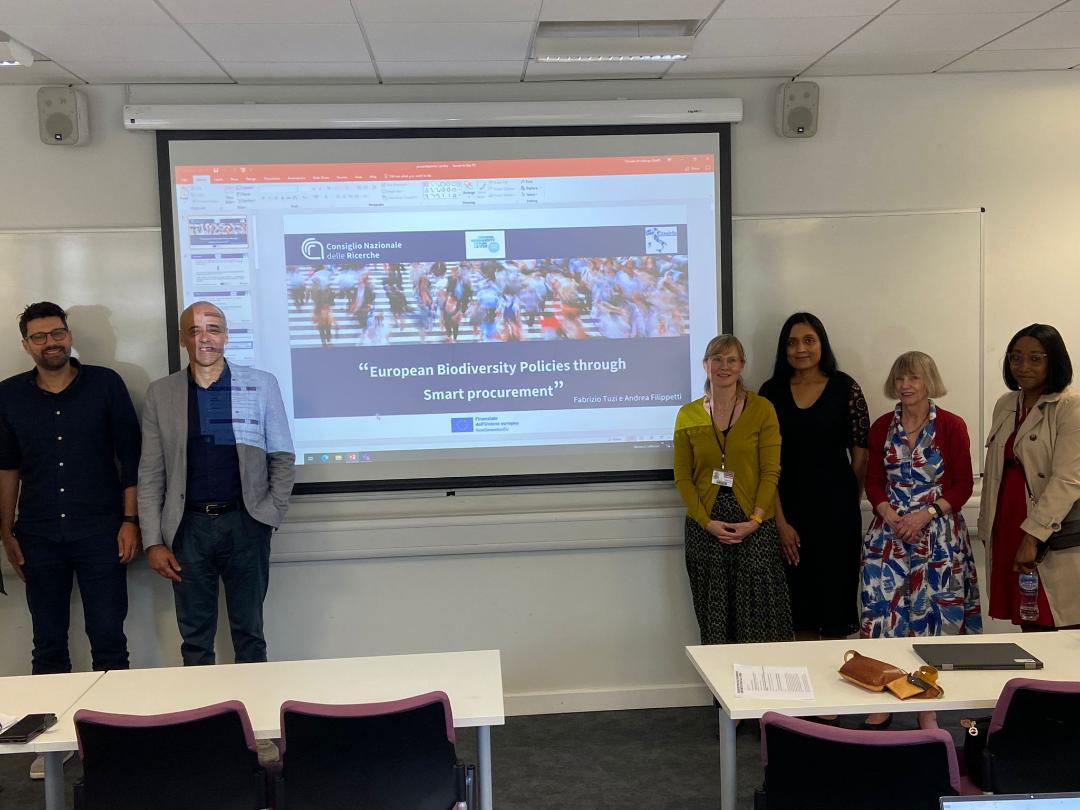On June 19 2024 we were pleased to host an hybrid CIMR Debate about Public Policy for Innovation with our speaker Dr. Fabrizio Tuzi, senior researcher at Institute on Regional Studies – Italian National Research Council, and the discussants Prof. Daniele Archibugi, and Prof. Helen Lawton Smith. The event was chaired by Dr. Marion Frenz.
The focus of the debate was the effectiveness of demand side policies, in particular public procurement for innovation. A issue is the role of governments in addressing market failures or using a systems approach to overcome weaknesses in national research and development capacity and utilisation as well as what Public Procurement or Innovation (PPI) is actually for.
Understanding Public Procurement for Innovation (PPI)
When Public organizations order for something (normally a product, a service or a system) that it is not already turnkey available, and that it requires to be created, developed or adjusted, it is required that the supplier carry out some R&D or innovative effort before it can be delivered. The phenomenon is called: Public Procurement for innovation (PPI)
The goal of PPI is not primarily to enhance the development of new products, but to target solutions/functions to address society’s problems and meet human needs.
Public Procurement in Europe: An overview
Public procurement in Europe as a whole is a large component of GDP and, according to OECD estimates, varies across countries from 10 to 16 per cent of the GDP. In practice, very little of it goes explicitly on innovation while the embedded innovative component of ordinary procurement is difficult to bring it up. This is particularly pronounced in the lack of deployment of this policy tool for addressing the grand environmental challenge of biodiversity. In Italy this tool is underutilised and sub-optimally used.
This problem is of particular concern to the Italian National Future Biodiversity Centre which funded the study. What might be done to improve policy pathways: how are governments using this tool to address biodiversity issues, what challenges they intend to address, and what are governments procuring from the market? In other words, what might be done to phase out established practices that are not fit for purpose (OECD, 2024) to ensure that there are better outcomes? In answer, setting spending targets could provide an effective way to improve the use of innovative public procurement. This means shifting a share of total procurement spending to innovative procurement, as is the case in the United States or South Korea.
Challenges in Utilizing PPI for Biodiversity: the case of Italy and UK
Particular issues relating to Italy relate not only to that PPI is a procedure hardly used and also when it is, there is a distinct lack of small and medium sized enterprises being given contracts. This gap is particularly problematic since Italy is one of the countries in Europe with the largest share of SMEs. Italy is still disinclined to support procurement for innovation, in general and more markedly in the biodiversity sector. The introduction of selection criteria based on innovative solutions rather than the lowest price and the reduction of administrative burdens could shift Italian procurement toward greater involvement of SMEs in tenders.
From the UK perspective, Fabrizio highlighted that public procurement expenditures as a share of GDP also increased in the United Kingdom (13.1% to 15.7%). He also gave an example of good practice from Scotland. This is CivTech, part of the Scottish Government’s Digital Directorate and is an innovative experiences of fostering public smart procurement The CivTech Process — CivTech. Other good practice examples are Ingnite Sweden and Innovative Solutions Canada (see OECD, 2022).
Policy Recommendations for Improving PPI
Important issues arising from the study are twofold. The first is the need for more quantitative analysis to test for correlation the public procurements and the production of patents in the biodiversity issues area in order to draw a representative picture of the effectiveness of this tool and provide more useful recommendations. The second is that analysis of the innovation pathways of firms participating in procurement for innovation is needed to see whether tendering is a useful tool for encouraging innovative behavior in firms engaged in biodiversity issues.
Daniele Archibugi, as discussant, pointed out that attempts by governments to increase and to foster R&D expenditure and innovation and within the business sector are always welcomed because of the externalities generated. However, there are enormous difference across national innovation systems in the way in which governments promote R&D and innovation in the business sector. Some nations carry out an important amount of R&D within the public sector and this generated the capabilities that companies can exploit for their specific innovative products, processes and services. The UK case is interesting because the government is less inclined to do in-door activities, and it is more inclined to buy as much as possible from the sector. This guarantees more flexibility in government actions. Other governments prefer to carry out production in-door.
However, when governments decide to buy products, processes and services from the business sector, they can decide to include embodied and disembodied components. His question to Fabrizio was: “How is possible to distinguish, within government contracts to buy products from the business sector, the embodied and the embodied components?” Issuing contracts requires a public administration which knows where technology opportunities resides and in the majority of cases this technological opportunities are much better known by the corporations than by public servants. Therefore, to use effectively a PPI, you need to build a smart public administration, made of public servants with technical expertise. Few countries, and certainly not Italy, have got them.
A point raised is that PPI initiatives are more relevant for the periphery – regions which are falling behind. Often these measures can be used to help those places to catch up from targeting the mix it because the best universities and companies are there.
From the debate it is clear that there are multiple answers to what PPI is for. We looking forward to further questions and answers on this important topic.
Helen Lawton Smith, Fabrizio Tuzi and Daniele Archibugi, June 20 2024
References
OECD (2022) Promoting Start-Ups and Scale-Ups in Denmark’s Sector Strongholds and Emerging Industries https://www.oecd-ilibrary.org/industry-and-services/promoting-start-ups-and-scale-ups-in-denmark-s-sector-strongholds-and-emerging-industries_8f9bd7b0-en
OECD (2024), Agenda for Transformative Science, Technology and Innovation policies, OECD Science, Technology and Industry Policy Papers, OECD Publishing, Paris, https://doi.org/10.1787/ba2aaf7b-en

